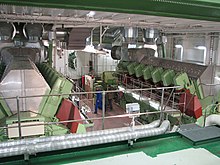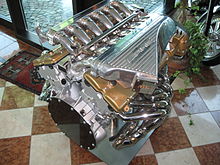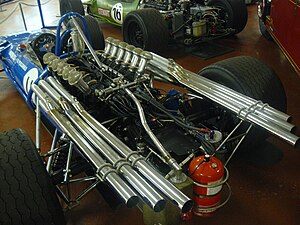
A V10 engine is a ten-cylinder piston engine where two banks of five cylinders are arranged in a V configuration around a common crankshaft. V10 engines are much less common than V8 and V12 engines. Several V10 diesel engines have been produced since 1965, and V10 petrol engines for road cars were first produced in 1991 with the release of the Dodge Viper.
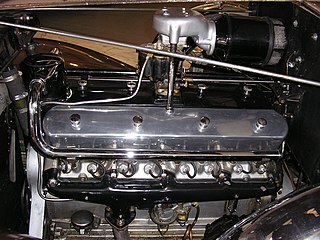
A V16 engine is a sixteen-cylinder piston engine where two banks of eight cylinders are arranged in a V configuration around a common crankshaft. V16 engines are less common than engines with fewer cylinders, such as V8 and V12 engines. Each bank of a V16 engine can be thought of as a straight-eight, a design that can be inherently balanced. Most V16 engines have a 45° bank angle.

The straight-eight engine or inline-eight engine is an eight-cylinder internal combustion engine with all eight cylinders mounted in a straight line along the crankcase. The type has been produced in side-valve, IOE, overhead-valve, sleeve-valve, and overhead-cam configurations.

A flat-twelve engine, also known as a horizontally opposed-twelve, is a twelve-cylinder piston engine with six cylinders on each side of a central crankshaft.

Maybach is a German luxury car brand owned by and a part of Mercedes-Benz AG. The original company was founded in 1909 by Wilhelm Maybach and his son Karl Maybach, originally as a subsidiary of Luftschiffbau Zeppelin GmbH, and it was known as Luftfahrzeug-Motorenbau GmbH until 1999.

An overhead camshaft (OHC) engine is a piston engine in which the camshaft is located in the cylinder head above the combustion chamber. This contrasts with earlier overhead valve engines (OHV), where the camshaft is located below the combustion chamber in the engine block.

The Rover V8 engine is a compact OHV V8 internal combustion engine with aluminium cylinder block and cylinder heads, originally designed by General Motors and later re-designed and produced by Rover in the United Kingdom. It has been used in a wide range of vehicles from Rover and other manufacturers since its British debut in 1967.

In automotive engineering a multi-valve or multivalve engine is one where each cylinder has more than two valves. A multi-valve engine has better breathing and may be able to operate at higher revolutions per minute (RPM) than a two-valve engine, delivering more power.

The Ferrari Colombo Engine was a petrol fueled, water cooled, carburetted 60° V12 engine designed by Gioacchino Colombo and produced in numerous iterations by Italian automaker Ferrari between 1947 and 1988. The maker's first homegrown engine, its linear successor is the Lampredi V12, which it far outlived, the last Lampredi being made in 1959.

The Liberty L-12 is an American water-cooled 45° V-12 aircraft engine displacing 1,649 cubic inches (27 L) and making 400 hp (300 kW) designed for a high power-to-weight ratio and ease of mass production. It saw wide use in aero applications, and, once marinized, in marine use both in racing and runabout boats.
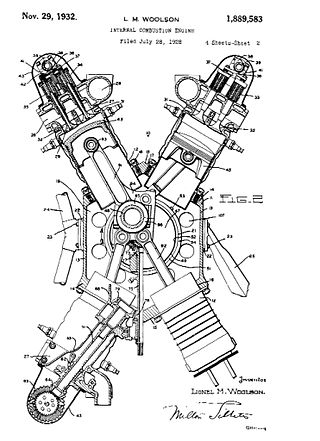
An X engine is a piston engine with four banks of cylinders around a common crankshaft, such that the cylinders form an "X" shape when viewed front-on.

The Maybach HL230 was a water-cooled 60° 23 litre V12 petrol engine designed by Maybach. It was used during World War II in medium and heavy German tanks, namely the Panther, Jagdpanther, Tiger II, Jagdtiger, and later versions of the Tiger I and Sturmtiger.
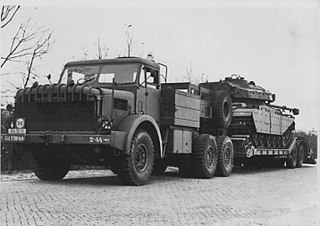
The Rolls-Royce Meteorite, also known as the Rover Meteorite, was a post-war British 18.01 L (1,099 cu in) V8 petrol or diesel engine was derived from the Rolls-Royce Meteor tank engine.

A V8 engine is an eight-cylinder piston engine in which two banks of four cylinders share a common crankshaft and are arranged in a V configuration.

The Ford GAA engine is an American all-aluminum 32-valve DOHC 60-degree liquid-cooled V8 internal combustion engine with a flat-plane crank designed and produced by the Ford Motor Company before and during World War II. It features twin Stromberg NA-Y5-G carburetors, dual magnetos and twin spark plugs making up a full dual ignition system, and crossflow induction. It displaces 1,100 cu in (18 L) and puts out well over 1,000 pound-feet (1,400 N⋅m) of torque from idle to 2,200 rpm. The factory-rated net output was 500 hp (370 kW) at 2,600 rpm.

The Packard 1A-2500 is an American V-12 liquid-cooled aircraft engine designed by Packard in 1924 as a successor to the World War I-era Liberty L-12. Five aero variants were produced, of which the 3A-2500 was the most numerous. Three marine versions, used most prominently in American World War II PT-boats, the 3M-2500, 4M-2500, and 5M-2500, were also derived from it.
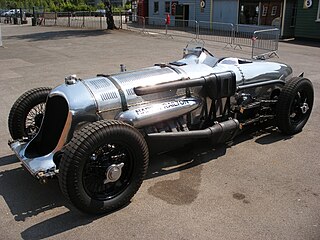
An aero-engined car is an automobile powered by an engine designed for aircraft use. Most such cars have been built for racing, and many have attempted to set world land speed records. While the practice of fitting cars with aircraft engines predates World War I by a few years, it was most popular in the interwar period between the world wars when military-surplus aircraft engines were readily available and used to power numerous high-performance racing cars. Initially powered by piston aircraft engines, a number of post-World War II aero-engined cars have been powered by aviation turbine and jet engines instead. Piston-engined, turbine-engined, and jet-engined cars have all set world land speed records. There have also been some non-racing automotive applications for aircraft engines, including production vehicles such as the Tucker 48 and prototypes such as the Chrysler Turbine Car, Fiat Turbina, and General Motors Firebirds. In the late 20th century and into the 21st century, there has also been a revival of interest in piston-powered aero-engined racing cars.

Vittorio Jano designed a new 60° V12 engine for sports car racing for Ferrari. This new engine, introduced in 1956, combined elements of both Colombo and Lampredi engines with new features. Engine architecture was more of Lampredi school but retained smaller Colombo internal measurements. Jano moved to Ferrari along with his designs for the Lancia D50 in 1955 and went on to design not only a new V12 but also a family of the Dino V6 engines soon after. Some of the technical ideas came from the Jano's Lancia V8 DOHC engine, intended for Formula One. This family of engines replaced Lampredi inline-4s known from Ferrari Monza line and went on to win many international races and titles for Ferrari. The design team comprised Jano as well as Vittorio Bellentani, Alberto Massimino, and Andrea Fraschetti.
Leo William Goossen was a draftsman, mechanical engineer and automobile designer. He is known for his work with Harry Miller and his long involvement in the design and ongoing development of the four-cylinder Offenhauser ("Offy") racing engine.


